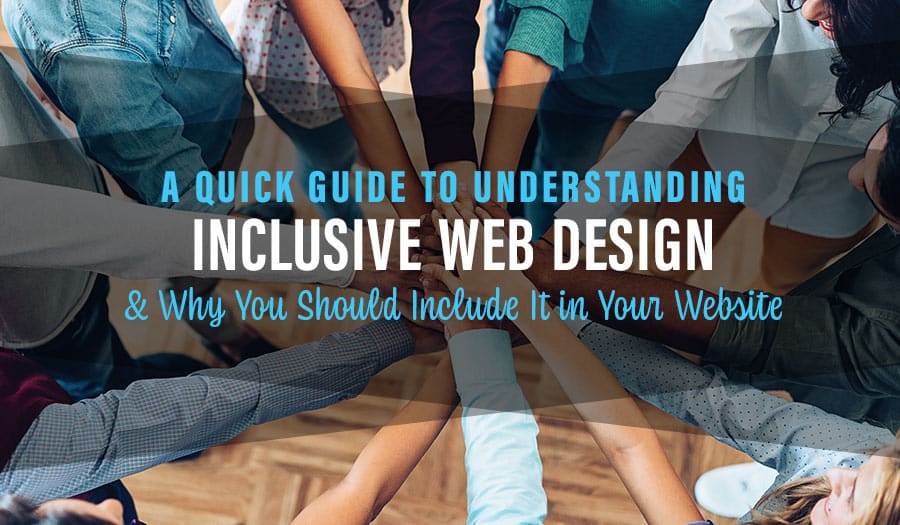It is important to understand that when designing a website, not every user interacts with it the same way. Inclusive web design means designing websites minding everyone who is permanently or temporarily disabled.
Inclusive web design usually removes bias and assumptions from a website so that users won’t feel excluded. Instead of assuming a one-size-fits-all user experience, the inclusive design aims to please a diverse range of individuals and accommodate a variety of experiences and ways of interacting with the world. Here are the benefits of inclusive website design and why you should include it in your website design.
What is Inclusive Design?
Inclusive design is a user experience (UX) methodology where designers consider the environment and circumstances of diverse user groups and demographics to ensure products are accessible to everyone rather than a narrow set of users.
Designers must avoid bias or assumptions when considering inclusive design like gender, age, race, and other generalized demographics. Following an inclusive web design encourages UX designers to think of permanent, temporary, and situational factors which prevent someone from using a digital product as intended.
Why Inclusive Design is Necessary
Inclusive design aims to support the full range of human diversity. While accessibility focuses on accommodating differing abilities between people, inclusive design usually incorporates differing perspectives, which include those people with disabilities. People who use digital products come from different backgrounds and have diverse life experiences. These experiences impact how they interact with the world, specifically how they interact with websites and apps.
Inclusive website design accommodates diverse experiences in the final product and the design process itself. The result of the inclusive design is a universal design that the maximum number of people can use. This is very important and necessary for you to include in your website design.
Principles of Inclusive Web Design
- Identify Exclusion
- Focus on Design as the Solution
- Equitable
- Avoid Personal Biases
- Scalable Text
Principles of Inclusive Web Design
Here are the principles of inclusive web design that you should think consider when designing your website:
1. Identify Exclusion
When approaching your design, proactively seek out points of exclusion and use them to generate new ideas and highlight opportunities to create new, inclusive solutions. Once designers understand exactly how and why people are excluded, they are able to help establish concrete steps towards being more inclusive.
2. Focus on Design as the Solution
Once you’ve identified some points of exclusion, you will need to translate this into actionable design choices. Essentially, this is where you bridge the connection between problems and solutions. An example problem might be identifying that your design excludes users in the context of direct sunlight. The design solution would be to increase the contrast so that the relevant information is more easily visible.
3. Equitable
It’s important to note that this principle is not about making your website look the same and work on every device but rather providing different user experiences with equally valuable outcomes. You can do this by making real users partake early in the research and testing phase.
If you have limited resources, you can look for sources of funding. You can also get in touch with disability charities to help you get in touch with real users.
4. Avoid Personal Biases
In order to avoid any unintentional, personal biases ending up in your designs, involve people from different communities throughout the design process. To help accomplish this, include certain user communities across your research and testing phase.
5. Scalable Text
For those who are visually impaired, having the ability to change the size of text on your website without altering the form of the website is very important. In general, this should include an up to 200% increased size for content or elements text, and the function be easily seen at the top or bottom of the website or simply integrated within the browser.
Benefits of Inclusive Web Design
- Effective Targeting
- It Improves User Experience
- Improve Your Team’s Motivation and Engagement
- Positive Social Impact
Benefits of Inclusive Web Design
Here are the benefits of inclusive web design that you should know and pursue:
1. Effective Targeting
Inclusive design aims to offer the same technology for all users, whether with special needs, disabilities, or neither of these. Often, impairments are not permanent but temporary. In many situations, the same inclusive design can thus benefit able-bodied users quite well. Adverse situations are overcome with the same innovations that tackle permanent impairment.
It’s important to really get to know those user groups which gain the most from inclusive design. It’s not enough to read about adults and children with special needs or disabilities: the designers should spend time with them. By observing their frustrations firsthand, then it’s possible to create an inclusive design successfully.
2. It Improves User Experience
Most people think that a website design is more usable if it’s accessible and inclusive. When your website is designed inclusively, it improves the experiences of your website visitors and encourages them to interact with various pages and features available there. This means website retention rates are high, increasing the chances of a visitor converting into a customer. Here are features that enhance a website’s accessibility:
- Voice control for hands-free navigation.
- Autocomplete prompts make text entry faster.
- High-contrast settings make your screen visible even with direct sunlight.
3. Improve Your Team’s Motivation and Engagement
Teams that prioritize inclusive web design are more likely to find meaningful purpose in their work. Everyone in the company feels valued and catered for because they can easily navigate the company’s website and access whatever information they require. This boosts team members’ satisfaction and productivity. According to research, people who find purpose in their job are more likely to stay at their company than those motivated primarily by income or achievement.
4. Positive Social Impact
People’s ability to participate is usually influenced by the things in their environment. To positively impact the world, designers provide tools to enable people to do so. It generates an opportunity for interaction with the environment. According to World Health Organization (WHO) studies, social exclusion hurts people’s physical and mental health. When your website is designed to be inclusive, it creates a positive social impact for your business.
At PixelFish, our team of experienced WordPress Website Designers creates visually stunning and engaging websites that communicate our client’s values and help grow their business through lead generation and online sales. We focus on creating inclusive websites so that all your users feel valued and catered for when interacting with your products. Contact us for more information.
Take your business to the next level with a Pixel Fish Website.
Check out some of our latest Website Design projects.
Further Information
Pixel Fish Hosting, Support & Maintenance
Is your WordPress Hacked? Here are 5 Potential Reasons
Read More
10 Point Business Web Design Checklist for a Perfect Business Website
How to Create a Unique Selling Proposition (USP) to Grow Your Business
7 Hot Tips to Help you Design and Launch Your Website
Flying High: How to Promote your website after launch
What You Need to Know About Inbound Marketing in a Nutshell
How to Scale Your WooCommerce Website as Your Business Grows
10 Website Imagery Tips for Improving Your Business Website
PayPal vs Merchant Bank Account: Pros & Cons
Why Honesty on your website Really is The Best Policy
8 WordPress Myths Busted: Debunking WordPress Myths
How many pages should my website have for SEO?
5 Time Saving Tips for Ecommerce Web Store Owners
Consequences: What Happens if You don’t get a Business Website
Top 4 Ways a Bad Website Can Hurt Your Business
Website Design Form vs Function: Finding the Perfect Balance
8 Cutting-Edge Web Design Trends to Incorporate Into Your Website
5 Principles of Intelligent Database Marketing
10 Benefits of Using WordPress for Your Business Website
New Horizons: Augmented Reality Impact on Web Design
10 Top Web Designer Traits You Should Look Out For
How to Choose the Perfect Blog Topics for Your Website



